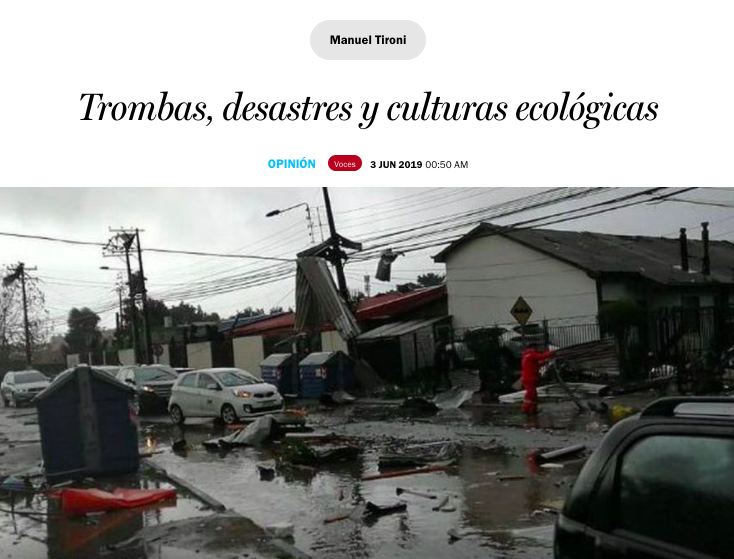By Manuel Tironi.
As I witness the waterspouts that swept through Concepción and Talcahuano, my daughter is doing her geography homework. She is in 6th grade and, ironically, the title of her homework is “Locating Chile’s natural hazards”. The first page of the guide lists our local disasters (earthquakes, tidal waves, draughts, volcanic eruptions, floods, alluviums and snowfalls) and the relevant regions where they took place. I wonder why fires, heat waves and tornados do not appear therein, especially as we look at images of Los Ángeles. I also wonder why they still call them “natural” hazards: if “natural” processes are those arising from and developing beyond human intervention, these phenomena would hardly fall within this category.
But what strikes me most is the abstraction of the homework. I wonder if, other than knowing that alluviums strike Chile and that they concentrate in certain regions, my daughter knows that no more than 2 kilometers from her school, there is a stream where an alluvium left 26 people dead, 8 people disappeared and more than 32,000 were affected by it. So, I ask her, do you know the rivers that run by your house? “The Mapocho River!”, she cries out loud, and then she adds that there is also another river meeting the Mapocho downstream (“Maipo River”, I help her). She cannot identify the San Carlos Canal that runs a few meters from her house, or the San Ramon canal, which runs even closer. Needless to say, she does not know the Macul stream, which breached its banks in 1993, causing the aforementioned damages. She also ignores that we are surrounded by four active volcanoes. I asked her if she knew what the San Ramon fault line was. “No idea”, she replied with brutal honesty. Her school sits literally over this fault.
I go back to the images of Concepción, Talcahuano and Los Ángeles. I pay attention to the comments. The astonishment appears to be twice as much. They are not supposed to occur in Chile. They do, though scarcely, and said infrequency seems to be enough for them to disappear from the collective memory and be virtually forgotten. “TropiConce” is on the social networks. And secondly, due to ignorance: waterspouts and tornadoes not only are “foreigner”, but also unknown. What are waterspouts? What causes a waterspout? Storm cells? I wonder how, despite living by the sea, people can ignore what a waterspout is, and why my daughter ignores that she leaves by a mountain estuary and that she spends half her day over a fault line.
Faced with a planet where biophysical life conditions are changing abruptly— “normal” temperature, the geomorphological characteristics of our direct environment, climate differences between the different seasons of the year—, creating ecologic culture is a pressing issue. By ecologic culture, I mean knowledge about our environment’s characteristics; practical and experiential knowledge about the geological, atmospheric, climatic and ecological features of the place we live in. Territorial memory about nature and its changes. Things we had until some time ago, and that still survive in local indigenous, peasant or rural communities, or in those that maintain a vital connection with their habitat.
Recovering this ecologic culture is essential. According to the National Environmental Survey –conducted by the UC Institute of Sociology – 93% of Chileans believe climate change is quite or very important. Climate change is raising concern in their daily lives, their domestic routines and immediate existence. This is certainly not surprising. With extreme rains in the Far North, tornadoes in the south, general draught and mega-fires every year—with the new and amplified anthropic disasters we are currently facing- climate change is no longer an abstract phenomenon occurring somewhere far away. Within this context, creating ecological culture becomes essential. We need to know how the valleys, plateaus and coasts we live in were formed, and how they have changed over time. We need to know what living near a forest or the Pacific Ocean means, be aware of the characteristics of the mountains, lakes and salares around us, and we must be able to identify a waterspout, tsunami or alluvium.
Children in Chile must go out into the field and get to know their environment, in order to feel part of an ever-changing nature and to listen to the elders’ stories and understand where they live. It is not only about redesigning the “geography» subject, but about rethinking our way of relating to a changing world in a comprehensive manner. Ecological cultures are instilled at school, in the neighborhood, at home and in the media, and they also need science, spirituality, arts and local knowledge.
I go back to thinking about my daughter. I can’t help recalling the potential seismic activity of the San Ramon fault. Nevertheless, I, her family, her school community, ideally her municipality and the country’s decision makers, can help her and all inhabitants of the Andean foothills in Santiago understand this geological phenomenon, recognize its activity, develop care strategies and invent creative ways of coexistence. The same happens with waterspouts, volcanic eruptions and tsunamis; with the children of Cobquecura, Ollagüe or Saavedra. This is the only way of having resilient communities that are capable of building a more sustainable future.
Click here to find the published piece.
